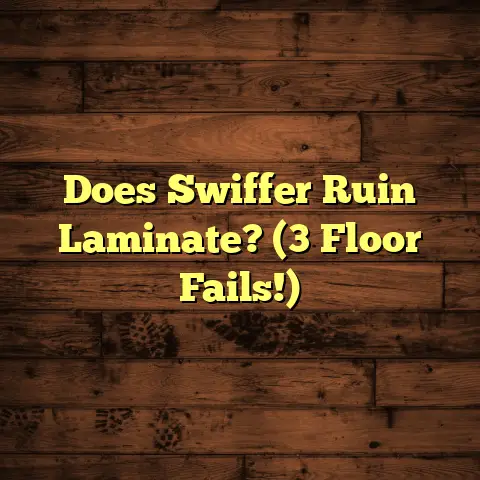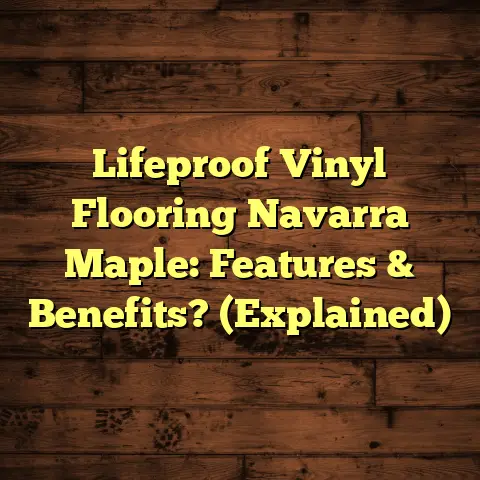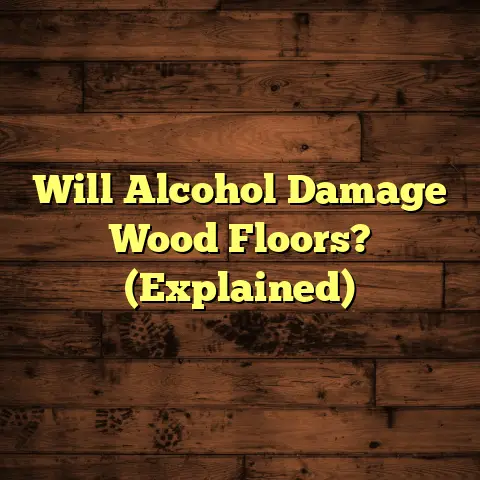Hardwood Floor Care: Best Tips? (1 Mistake Kills!)
There’s just something about the warmth and inviting nature of a beautiful hardwood floor, isn’t there?
I’ve seen countless homes transformed by the simple elegance of wood.
It’s not just about aesthetics; it’s the feeling you get walking on it, the sense of coziness and home it brings.
And with so many wood species to choose from – oak, maple, hickory, you name it – each floor tells a unique story.
But here’s the thing: that warmth and beauty require a little TLC.
Think of it like a classic car – stunning, but needs regular maintenance to keep it running (and looking) its best.
So, let’s dive into the world of hardwood floor care, shall we?
Section 1: Understanding Hardwood Floors
Before we get into the nitty-gritty of cleaning and maintenance, let’s make sure we’re all on the same page about what exactly a hardwood floor is.
Types of Hardwood Flooring
There are two main types you’ll typically encounter:
-
Solid Hardwood: This is the real deal – planks made from a single piece of wood. It’s durable, can be refinished multiple times, and adds serious value to your home. The downside? It’s more susceptible to moisture and temperature changes.
-
Engineered Hardwood: This consists of a thin layer of hardwood veneer glued to a core of plywood or high-density fiberboard. It’s more stable than solid hardwood, making it a better choice for basements or areas with high humidity. While it can be refinished, the number of times depends on the thickness of the veneer.
As a rule of thumb, solid hardwood is generally more expensive and considered higher quality, while engineered hardwood offers better stability and affordability.
The Anatomy of Hardwood
Ever wonder what makes a hardwood floor tick? It’s all about the layers.
The most important part is the finish. This is the protective coating that sits on top of the wood and determines how easy your floor is to maintain.
Common finishes include:
-
Polyurethane: Durable and water-resistant, making it a popular choice.
-
Oil-Based Finishes: Penetrate the wood, providing a natural look and feel. They require more maintenance but are easier to repair.
-
Aluminum Oxide: An incredibly durable finish often found on prefinished floors. It’s very scratch-resistant but can be difficult to repair.
The finish is your first line of defense against scratches, spills, and everyday wear and tear. Choosing the right finish and maintaining it properly is crucial for the longevity of your floors.
Section 2: The Importance of Care
Okay, so you’ve got beautiful hardwood floors. Now what? Why bother with all the cleaning and maintenance?
Why Care Matters
I can’t stress this enough: proper care is essential for preserving the value, longevity, and aesthetics of your hardwood floors.
Think of it as an investment.
A well-maintained hardwood floor can last for decades, adding significant value to your home. Neglecting it, on the other hand, can lead to costly repairs or even replacement.
Plus, let’s be honest, a clean and gleaming hardwood floor just looks amazing.
It elevates the entire look and feel of your home.
Common Misconceptions
I’ve heard it all when it comes to hardwood floor care. Let’s bust a few common myths:
-
“Hardwood floors are indestructible.” Nope! They’re durable, but not invincible. They’re susceptible to scratches, dents, and water damage.
-
“You can use any cleaning product on hardwood floors.” Absolutely not! Harsh chemicals can strip the finish and damage the wood.
-
“Mopping is always the best way to clean hardwood floors.” Not necessarily. Over-mopping can lead to water damage.
-
“Refinishing is a one-time thing.” Nope, it depends on traffic, wear, and the type of finish used.
These misconceptions can lead to poor care practices and ultimately damage your floors.
Section 3: Best Tips for Maintaining Hardwood Floors
Alright, let’s get down to the good stuff! Here are my top tips for keeping your hardwood floors looking their best:
1. Regular Cleaning Routines
Consistency is key! A regular cleaning schedule will prevent dirt and debris from building up and scratching the finish.
-
Dusting/Sweeping: Aim to dust or sweep your floors at least once a week, or more often in high-traffic areas. Use a soft-bristled broom or a microfiber dust mop. I personally love microfiber mops because they trap dust and dirt effectively without scratching the surface.
-
Vacuuming: Use a vacuum cleaner with a soft brush attachment to remove dirt and debris from cracks and crevices. Avoid using a beater bar, as it can scratch the finish.
2. Moisture Management
Water is hardwood’s enemy! Excess moisture can cause warping, cupping, and staining.
-
Humidity Control: Maintain optimal humidity levels in your home, ideally between 30-50%. Use a humidifier or dehumidifier as needed.
-
Spill Cleanup: Clean up spills immediately with a dry cloth. Don’t let liquids sit on the surface for extended periods.
3. Proper Mopping Techniques
Mopping is necessary, but it’s crucial to do it right.
-
Damp Mopping: Use a damp mop, not a soaking wet one. Wring out the mop thoroughly before applying it to the floor.
-
Appropriate Cleaning Solutions: Use a pH-neutral cleaner specifically designed for hardwood floors. Avoid using harsh chemicals, abrasive cleaners, or vinegar.
-
My Go-To Recipe: A mixture of water and a few drops of mild dish soap can work in a pinch, but always test it in an inconspicuous area first.
4. Protective Measures
Prevention is always better than cure!
-
Area Rugs and Floor Mats: Place area rugs in high-traffic areas, such as entryways, hallways, and in front of sinks. Use floor mats at doorways to trap dirt and moisture.
-
Furniture Pads: Attach felt pads to the legs of all furniture to prevent scratches and dents. Replace the pads regularly as they wear down.
5. Periodic Maintenance
Even with the best care, hardwood floors will eventually need some extra attention.
-
Sanding and Refinishing: Sanding removes the old finish and any imperfections, while refinishing applies a new protective coating.
-
How Often? The frequency of sanding and refinishing depends on the amount of traffic, the type of finish, and how well you maintain your floors. As a general rule, you might need to refinish every 7-10 years in high-traffic areas, or every 15-20 years in low-traffic areas.
6. Avoiding Direct Sunlight
UV rays can fade and damage hardwood floors over time.
-
Window Treatments: Use curtains, blinds, or shades to block direct sunlight.
-
UV-Resistant Finishes: Consider using a UV-resistant finish when refinishing your floors.
Section 4: The One Mistake That Can Kill Your Hardwood Floors
Okay, folks, we’ve covered a lot of ground. But now it’s time to talk about the big one.
The one mistake that I see homeowners make all the time that can absolutely wreck their hardwood floors.
Identify the Mistake
What is this cardinal sin of hardwood floor care? Drumroll please…
Using the wrong cleaning products!
I know, it sounds simple, but it’s a huge problem.
I can’t tell you how many times I’ve walked into a home and seen floors that are dull, streaky, or even damaged because someone used the wrong cleaner.
Consequences of the Mistake
Using the wrong cleaning products can lead to a whole host of problems:
-
Stripping the Finish: Harsh chemicals can strip away the protective finish, leaving the wood exposed and vulnerable.
-
Discoloration: Some cleaners can cause discoloration or staining, especially on lighter woods.
-
Warping: Excessive moisture from the wrong cleaning method can cause the wood to warp or cup.
-
Residue Buildup: Some cleaners leave behind a sticky residue that attracts dirt and makes your floors look dull.
Real-Life Examples
I remember one client who used a generic all-purpose cleaner on their beautiful oak floors for years.
Over time, the cleaner stripped away the finish, leaving the wood exposed.
The floors became dull, scratched easily, and eventually started to warp.
The cost to repair the damage was significantly more than if they had used the right cleaner from the start.
Another client used vinegar and water to clean their floors, thinking it was a natural and safe option.
While vinegar is a great cleaner for some things, it’s too acidic for hardwood floors.
It etched the finish, leaving them looking cloudy and dull.
These are just two examples of how using the wrong cleaning products can have devastating consequences for your hardwood floors.
Section 5: Conclusion
We’ve covered a lot today, from understanding the different types of hardwood floors to the importance of regular cleaning and maintenance.
I hope you’ve found these tips helpful and that you’re feeling more confident about caring for your own hardwood floors.
Recap the Importance of Care
Remember, diligent care is key to enjoying the beauty and warmth of your hardwood floors for years to come.
Regular cleaning, moisture management, protective measures, and periodic maintenance are all essential for preserving their value and longevity.
Call to Action
So, what are you waiting for? Take a look at your current hardwood floor care routine and see if there’s anything you can improve.
Make sure you’re using the right cleaning products, protecting your floors from scratches and spills, and maintaining optimal humidity levels in your home.
And most importantly, avoid the critical mistake of using the wrong cleaning products!
Your floors (and your wallet) will thank you for it.
Happy cleaning!





